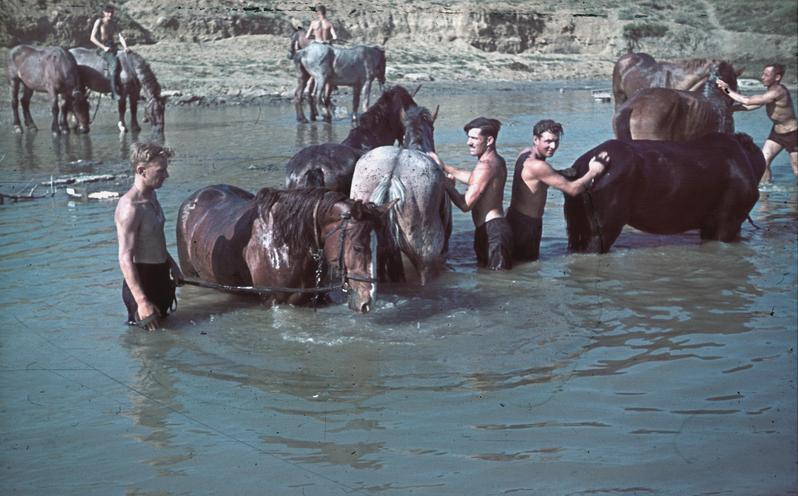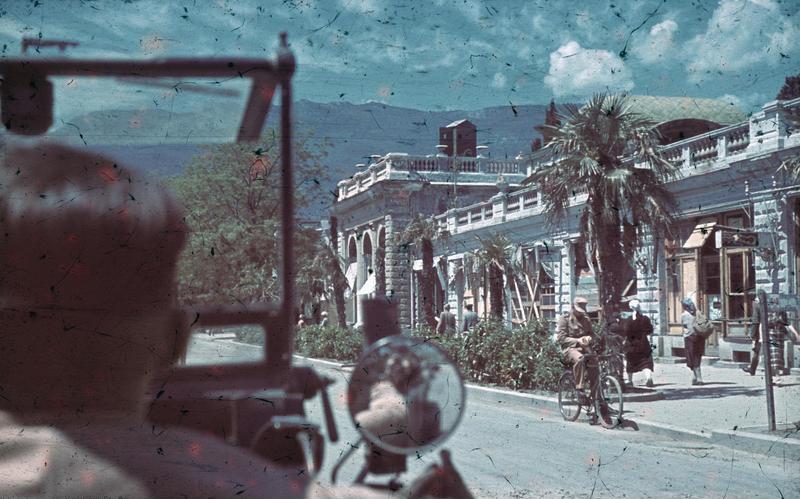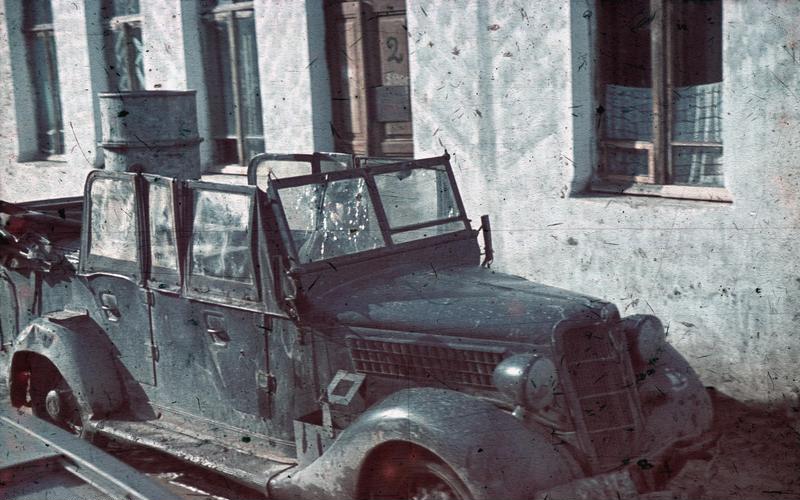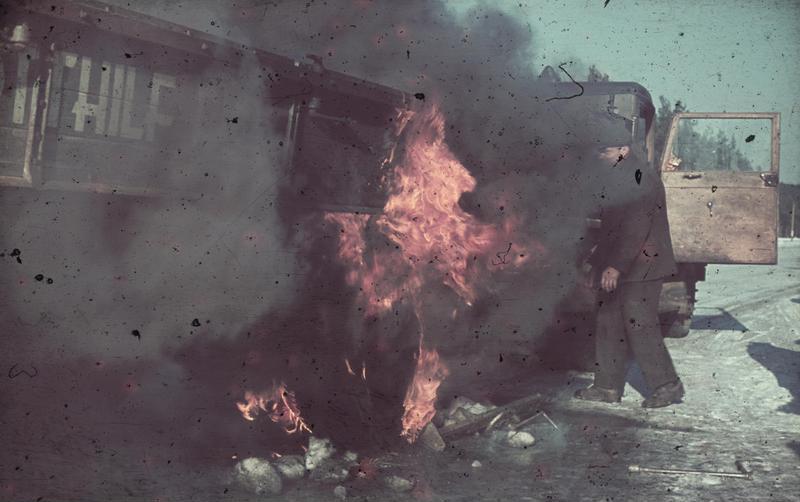.

German soldiers, Simferopol, Crimea, Soviet Union: photo by Horst Grund, c. December 1941 (Deutsches Bundesarchiv/German Federal Archive)
Crimea, Soviet Union, soldiers on leave from the front: photo by Horst Grund, c. 1942 (Deutsches Bundesarchiv/German Federal Archive)

Crimea, Soviet Union, recovery from the front, soldiers on the beach washing horses: photo by Horst Grund, c. 1942 (Deutsches Bundesarchiv/German Federal Archive)
Crimea, Soviet Union, soldiers at the beach, on leave from the front: photo by Horst Grund, c. 1942 (Deutsches Bundesarchiv/German Federal Archive)
Simferopol, Crimea, Soviet Union, cameraman in Marine propaganda unit military vehicle: photo by Horst Grund, c. 1942 (Deutsches Bundesarchiv/German Federal Archive)
Simferopol, Crimea, Soviet Union, windshield of Marine propaganda unit vehicle shot out during partisan attack: photo by Horst Grund, c. December 1941 (Deutsches Bundesarchiv/German Federal Archive)
Military truck burning, Yalta, Crimea, Soviet Union: photo by Horst Grund, c. 1942 (Deutsches Bundesarchiv/German Federal Archive)






Just yesterday I was describing to someone what you were doing with the FSA photo archive and I also mentioned to them the German Federal Archive. It's always remarkable to see what you've drawn from it to post. The color photography and the title you've given the piece makes this particularly real and grim. I suppose I always thought it would look something like this, i.e., a bit varied, a lot the same, and simply hopeless. I've never been in war or in a war zone, but I was once the victim of a very scary crime in in Mexico City and the photos bring back acutely the sense that someone wants you dead, is making efforts to achieve that and you don't know when it might happen.
ReplyDeleteCurtis,
ReplyDeleteYes, that's the approximate plot here. Of course the "narrative" as such, in my ordering of the pictures from the scattered evidences in the files, is an imposition upon history, but I think it's probably a fair approximation of what was going on.
Horst Grund was born in Berlin in 1915, and came of age into the world of the Thousand Year Reich. At twenty-three he became a camera assistant, and then a few years later a war correspondent in a Marine propaganda unit. He was assigned to cover the war on the Eastern front; he spent time with Axis forces in Romania, followed the advance into the Ukraine, and went south toward the Black Sea and Crimea with Army Group D. His photos of the siege of Sevastopol stand as the principal remaining historical evidence of what that terrible campaign actually looked like. In 1943 he went on to Sicily, where once again he left an invaluable historical record. The things he may have seen... one shudders to think.
But he was a photographer not a warrior, and he took care.
He survived the war, and from 1950 to 1977 continued to work successfully as a newsreel photographer. He lived until 2001.
The wartime correspondents were expected to put themselves into the middle of the action, even if that meant harm's way. Of course the images were edited for use. Battlefield photography usually concentrated on equipment rather than persons; the sufferings of the victims, as one might expect, were rarely if ever shown. Still there is an undeniable feeling of historical verisimilitude, often unintended; the damage to the film speaks volumes as to the circumstances.
It's interesting to consider the German propaganda photography up against the American propaganda photography produced by the OWI.
The greenish undersea tones in the blue range immediately tell us it is Agfa and not Eastman supplying the film.
And of course the OWI work is all carefully staged, whereas Horst Grund's files are full of shots that include explosions and flying debris, things that obviously could not have been staged.
I have been studying the mysterious history of Horst Grund for some time. He was, it would seem, a human being. He left behind tender shots of his mother, taken on leave. On leave at the Black Sea, he took photos that perhaps suggest private relationships. Several shots in particular, of a woman on the beach, leave one to wonder whether there might have been a romantic connection.
One of those photos, as well as a dramatic shot of a sunken destroyer on fire in the the red mist of aerial and artillery bombardment in the port of Sevastopol, can be found on The Red Tower.
By the way, Curtis, speaking of the photos of the suffering victims that were meant never to be seen: the problem for the Nazis was that they wanted their cameramen to capture accurate and detailed records, but then inevitably there came instances in which the photographers, despite the obvious risks, concealed and preserved negatives that were meant to be either destroyed or kept secret; one such instance is the harrowing footage of a massacre in a village on Crete, which I posted in White Eyes.
ReplyDeleteThere is no getting around the fact that the hours spent in the Bundesarchiv files of the Third Reich provide a chilling reminder of the inescapable truth that the human race possesses a capacity for "inhuman" cruelty which may indeed, by one of those terrible ironies which make history such a painful study, comprise the salient defining characteristic of the species homo sapiens.
Thank you for the Grund background information (and the clue to discerning Agfa vs. Eastman negative stock). I hadn't previously mentally connected these with the Red Tower Grund photos, which were remarkable. I will never forget White Eyes. I think you've made an extremely plausible story from these pictures. I can never ever believe what these correspondents undertake to do. When I was in 6th grade, I had a friend whose father was a photographer with the US Infantry in Europe during WWII. He eventually assembled voluminous scrapbooks of his work. It was a long time ago and I can't remember things like specific events the photos were connected to or his methods of composition, such as they might have been, but I do recall depictions of injury, suffering and fear, which left a deep impression on me. We weren't looking at the books for any particular purpose. They were just an aspect of the life of my friend's family and as boys growing up at a time when WWII was fairly recent history, we were very interested in everything related to the war.
ReplyDeleteCurtis,
ReplyDeleteYes, those memories have a familiar ring for me as well. As a small boy I was in awe of everything connected with that war. Bits of military hardware possessed the aura of fragments of the True Cross. Perhaps it's the fact that none of that carnage ever occurred on our home soil that allowed us to be merely fascinated, from our relatively safe distance, rather than overwhelmed.
The statistic that sticks in my craw now: ninety million dead on the Ostfront, 1939-1945. That's an awful lot of erased humanity.
(A day of localized Armageddon here, fraught with din and chaos, launching into semi-organized house deconstruction, with the better half of the family meanwhile off again to cancer care, no sleep for anybody for days and nights on end... and several times I found myself reminding myself: well, it could be worse, it could be the Eastern Front in 1941.)